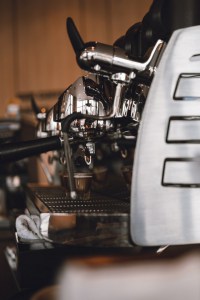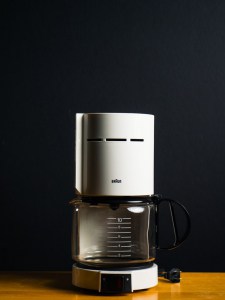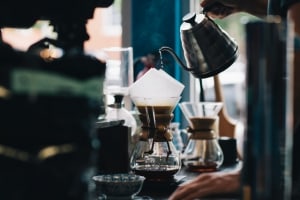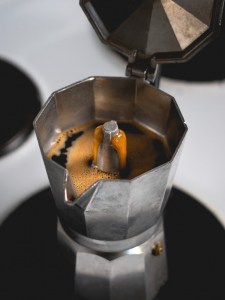As an Amazon Associate I earn from qualifying purchases.

There are quite a few perks of brewing your own coffee. At the very least, it helps save money. But coffee connoisseurs say that the trend with coffee these days is all about taste. It’s less about getting a kick out of your bed in the morning, and more about enjoying the drink. And with so many affordable, readily available coffee makers out there, drinking instant coffee is slowly becoming a thing of the past. Not to mention that one of the biggest instant coffee producers in the world – Nescafé – is owned by Nestle, a company that has a long, long list of transgressions against nature and humanity.
In any case, we’re here to introduce you to the four most popular types of coffee makers that can help you get a beautiful cup of java in the comfort of your home. We’ll go over the pros and cons of each coffee maker so that you can decide which one is the best choice for you depending on your lifestyle, budget, and taste.
1. Drip Coffee Makers

Drip coffee makers are also quite versatile in terms of quantity – you can get one that brews anything between one and fourteen cups of coffee.
How does it work?
Drip coffee makers work using electricity. You plug the machine in, fill up the filter tray with ground coffee, fill up the water pitcher with water, and set the carafe on the heating plate. All that’s left for you to do is to press the start button and wait for your coffee to brew. A shower head at the top drips the hot water into the coffee grounds, allowing it to extract them before it passes into the carafe ready to drink.
Pros:
A drip coffee maker is affordable, easy to use, and produces consistent results.
Cons:
There’s not a lot of variety in taste as far as the brewing process goes, but you can get some variety switching up the beans you use.
Another drawback is that if the carafe sits on the heating plate for too long, the coffee may start tasting a bit burnt.
We recommend it for:
Families, homes, offices, and entertaining. Instead of sitting at the stovetop, babysitting your brew while your guests wait in the living room, you can let the machine do it for you.
2. Espresso Machines

An espresso machine offers a lot of versatility, as you can recreate coffee shop specials like Americano, macchiato, cortado, and so on. If your espresso machine doesn’t come with a frothing wand, you can get your own milk frother to get that beautiful cream which is the signature ingredient in espresso-based beverages like cappuccino.
Espresso is usually made with dark roasts and fine grinds, which results in a concentrated, rich cup of coffee.
How does it work?
Espresso machines are electric-powered. There are different types you can choose from, which vary the level of labor that will be necessary on your part. You can decide between manual, semi-automatic, automatic, to super-automatic. The way they work is by heating water to a high temperature and allowing it to pass through a metal filter cup filled with pressed coffee grounds at quite a high pressure.
Pros:
Espresso machines can help you get consistently delicious, rich cups of espresso.
They also allow a lot of versatility to recreate coffee shop specials.
Plus, a lot of them come with a frothing wand.
Cons:
Espresso machines are usually quite a bit pricier than other coffee makers.
Other drawbacks of manual espresso machines are that they’re quite labor-intensive and require some technical knowledge.
We recommend it for:
Espresso enthusiasts and those who appreciate bold, rich-tasting coffee.
3. Pour-Over Coffee Makers

Taste-wise, pour-over coffee makers generally produce a delicious, full-bodied cup of java.
How does it work?
Pour-over coffee makers generally consist of a cup with a base that’s meant to go on top of mugs or carafes, and holes at the bottom that allow the coffee to pass through to the container below. The cup-shaped coffee maker has a cone-shaped funnel in which you place a paper filter and fill it up with medium ground coffee. Then, you slowly add water to the pour-over coffee maker in several phases. The first pour is meant to allow the coffee grounds to bloom, i.e. to activate them and extract the initial flavor. The following gentle pours are meant to finish the coffee grounds’ brewing process.
Pros:
Pour-over coffee makers are generally simple to use – although it’s important to take note of the series of pours to get the optimal taste of the coffee. They’re also quite compact and thus easy to travel with.
These coffee makers are also quite affordable.
Plus, they offer versatility when it comes to the amount of coffee you want to make.
Cons:
Making pour-over coffee is a process. It takes a hands-on approach on your part, and may require more time than some other coffee makers to brew the coffee.
We recommend it for:
Pour-over coffee enthusiasts and those who need a single cup of coffee at a time.
4. Moka Pots

Moka pots are one of the most affordable coffee makers you can get your hands on, and you can also use them to make espresso-based drinks like lattes and macchiatos.
Depending on the capacity of the Moka pot you buy, you’ll be able to create anywhere from one cup to twelve cups of coffee.
How does it work?
Moka pots work with stovetops or gas burners. They contain three chambers: the bottom chamber is filled with water, and the middle chamber (a metal filter) is filled with coffee grounds. As the water in the bottom chamber heats up, it generates steam. The pressure from the steam causes the hot water in the bottom chamber to travel up through the middle chamber where the coffee is, and extract it. Finally, it travels through a tube into the top chamber, where you get your lovely, piping hot, finished brew.
Pros:
Moka pots are quite eco-friendly – they don’t create any waste other than used coffee grounds (which you can always find uses for!).
Overall, Moka pots produce a consistently good cup of coffee and they’re a great, much cheaper alternative to espresso makers.
Lastly, they work pretty fast – so you won’t have to wait too long for your coffee to be ready.
Cons:
A Moka pot should be cleaned regularly, which can be a bit of a hassle considering it has three parts. To be fair, you should regularly clean any coffee maker you decide to get (or already own).
We recommend it for:
Anyone looking for an espresso alternative or a richly deep cup of coffee.
We also highly recommend it to campers – with a Moka pot, you’ll have coffee anywhere you go.
A Few Words Before You Go…
Hopefully, you enjoyed our guide to the most popular coffee makers you can get for your home. Depending on your taste, budget, or how much effort you’re willing to put it, you can decide which one’s right for you. And don’t forget – every perfect cup of coffee starts with freshly ground beans!
